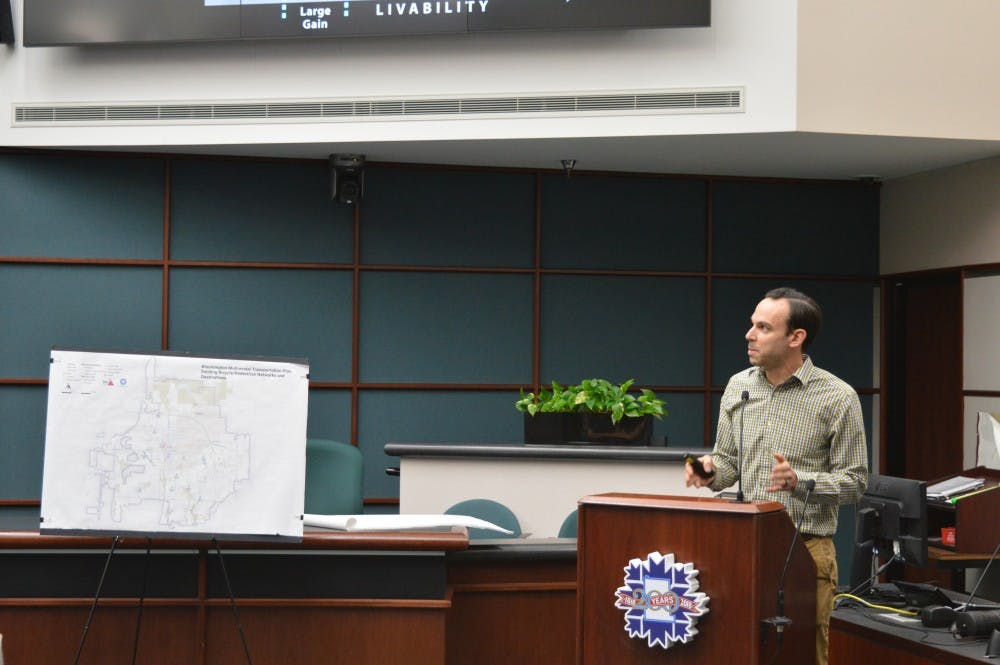Angled parking, roundabouts, restoration of two-way streets and separate bike lanes were among the transportation alterations proposed Thursday.
Sagar Onta and Ken Ray, consultants with Toole Design Group, led a presentation summarizing ideas and feedback they curated throughout their stay in Bloomington.
Ray said about 10 percent of bikers use all streets, while 60 percent prefer to ride on trails because of safety concerns. Adding more bike lanes would minimize conflict and increase safety.
About 40 members of the Bloomington community and government joined Onta and Ray at City Hall Thursday to review previously shared ideas for the creation of a Transportation Plan.
“It's your city. It's your plan,” Ray said. “We want to have people excited about things. We want people to be able to champion ideas that they like or impact them.”
Transportation is a component of Bloomington’s Comprehensive Plan, which is a planning document approved earlier this month designed to set goals for city improvement.
Bicycle and Pedestrian Coordinator Beth Rosenbarger said the city began its search for consulting firms last year before the Comprehensive Plan was officially adopted because Bloomington knew they wanted to create a more detailed transportation plan.
Onta said it's a good idea for cities to update their transportation plan at least once a decade. Bloomington’s last transportation plan was passed in 2002, 16 years ago.
The guiding principle for Bloomington transportation, as stated in the Comprehensive Plan, is to reduce dependence on automobiles.
Onta and Ray led the creation of a preliminary plan after arriving in Bloomington on Monday. On the first night of their visit, Onta and Ray held a discussion forum where members of the community voiced concerns and desires about the plan.
Since then, the team met with about 160 individuals from city government and interested organizations. They also made their own observations about the city’s transportation needs.
The meeting Thursday provided a space for Toole Design to receive feedback on their initial ideas before the consultants move forward.
"We bounce ideas and get feedback so we don't go in tangents that aren't feasible," Ray said.
After conducting studies and analysis based on the ideas established this week, Ray and Onta will return in May to present a formal draft where the public will have another chance to comment.
The City of Bloomington will publish the slides and audio recording of the Monday and Thursday presentations on the transportation section of their website to spread access to people who may not have been able to attend, but who still may wish to comment.
The presentation also included several examples of other cities like New York, Washington D.C. and South Bend, Indiana, which have successfully adopted changes similar to those proposed for Bloomington. Ray said there was no reason why Bloomington couldn't do the same.
“It’s not impossible. Things are very doable,” Ray said.
The meeting concluded with a brief Q&A session, and attendees were encouraged to submit detailed comment cards.
Alex Weiss Hills, a Bloomington resident and web developer at IU, said he liked that the consultants were thinking about ways to connect the outer areas of the city through bike paths and an expanded bus transit system. Although he lives close to College Mall, Weiss Hills said he doesn’t feel comfortable biking to the mall because doing so would require him to cross the busy College Mall Road.
Weiss Hills said one thing he didn’t hear the consultants address, and what he put on his comment card, was transportation to sporting facilities.
However, Weiss Hills said he likes the community aspect of the plan.
"It’s taking the focus away from the car, and more about interacting with the community,” Weiss Hills said. “Interacting with store owners and connecting the University to the town."
A caption in this article previously misnamed Ken Ray. The IDS regrets this error.




